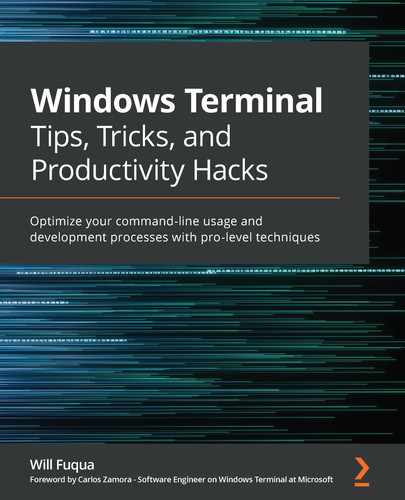Become an efficient command-line expert by harnessing the power of the new Microsoft Windows Terminal, and learn time-saving tricks for PowerShell, WSL2, and more Windows Terminal is a new and open-source command-line application for Windows 10, built for the Command Prompt, PowerShell, Windows Subsystem for Linux, and more. It's fast, modern, and configurable thanks to its GPU-accelerated rendering, excellent UTF-8 support, and JSON-based configurability, and this book can help you learn how to leverage these features. You'll start by learning the benefits of Windows Terminal and its open-source development, as well as how to use the built-in tabs, panes, and key bindings to build your own efficient terminal workflows. After you've mastered Windows Terminal, this book shows how to use and configure PowerShell Core and the Windows Subsystem for Linux within Windows Terminal. You'll maximize your productivity using powerful tools such as PSReadLine for PowerShell and ZSH on Linux, and discover useful tips and tricks for common developer tools like Git and SSH. Finally, you'll see how Windows Terminal can be used in common development and DevOps tasks, such as developing frontend JavaScript applications and backend REST APIs, and managing cloud-based systems like Amazon Web Services (AWS), Microsoft Azure, and Google Cloud. By the end of this book, you'll not only be well-versed with Windows Terminal, but also have learned how to effectively use shells like PowerShell Core and ZSH to become proficient at the command line. This book is for developers, DevOps engineers, and sysadmins who want to become advanced command-line power users. Whether you're new to the command line or you already use Windows PowerShell every day, this book will have something for you.Key Features
Book Description
What you will learn
Who this book is for
Table of Contents
- Windows Terminal Tips, Tricks, and Productivity Hacks
- Foreword
- Contributors
- About the author
- About the reviewers
- Preface
- Who this book is for
- What this book covers
- Section 1 – Introducing the New Windows Terminal
- Section 2 – Configuring your Windows Terminal and its shells
- Section 3 – Using your Windows Terminal for development
- To get the most out of this book
- Download the example configuration and code files
- Download the color images
- Conventions used
- Get in touch
- Reviews
- Section 1: Introducing the New Windows Terminal
- Chapter 1: Getting started with the new Windows Terminal
- Chapter 2: Learning the Windows Terminal UI
- Chapter 3: Configuring an Ubuntu Linux profile
- Section 2: Configuring your Windows Terminal and its shells
- Chapter 4: Customizing your Windows Terminal settings
- Chapter 5: Changing your Windows Terminal appearance
- Technical requirements
- Terminal color schemes
- Built-in color schemes
- Community-driven color schemes
- Writing your own theme
- Background images and translucency
- Customizing PowerShell with posh-git, oh-my-posh, and PSReadLine
- Oh-my-posh version 2
- Oh-my-posh version 3
- Changing the prompt without oh-my-posh
- Changing command colors with PSReadline
- WSL2 customization with oh-my-zsh
- Command Prompt customization
- Summary
- Chapter 6: Setting up keyboard shortcuts
- Chapter 7: Hidden Windows Terminal Actions
- Chapter 8: Tips for using PowerShell like a Pro
- Technical requirements
- Installing PowerShell Core
- Using built-in commands and aliases
- Automatic Variable: $^ and $$
- cd - and cd +
- The ii command
- History navigation with h and r
- Pipelines and $_
- Custom Profile Aliases and Functions
- Configuring PSReadLine in PowerShell Core
- EditMode
- History Search
- Better autocompletion
- Command predictions
- Programmable shortcuts
- Adding the GNU coreutils to the path
- Installing the z utility
- Addendum – the full PowerShell $profile file
- Summary
- Chapter 9: Tips for Using Ubuntu like an Expert
- Technical requirements
- Using Ubuntu with Windows
- Accessing Linux directories from Windows
- Accessing Windows directories from Linux
- Running Linux programs from inside Windows
- Running Windows programs from inside Linux
- Installing and configuring software
- Choosing your shell
- Using ZSH
- Rerunning earlier commands
- Using ZSH substitutions
- Configuring aliases and functions
- Quickly navigating to directories
- Installing and using oh-my-zsh plugins
- Enabling the z plugin
- Enabling vi-mode
- Installing zsh-autosuggestions
- zsh-syntax-highlighting
- Summary
- Section 3: Using your Windows Terminal for development
- Chapter 10: Using Git and GitHub with Windows Terminal
- Technical requirements
- Creating a modern Git installation
- Installing Git
- Installing OpenSSH
- Starting our OpenSSH Agent
- Setting up a private/public key pair
- Testing our SSH authentication
- Authenticating with Git on Linux
- Tips for using Git effectively
- Switching Git branches with git checkout -
- Fixing typos with Git's autocorrect
- Pushing to HEAD
- Git aliases and command aliases
- Tig
- Viewing files on different branches
- git reflog
- Using GitHub from Windows Terminal
- Creating repositories
- Viewing pull requests
- Checking out Pull Requests
- Summary
- Chapter 11: Building web applications with React
- Chapter 12: Building REST APIs with C# and Windows Terminal
- Chapter 13: Connecting to remote systems
- Chapter 14: Managing systems in the cloud
- Appendix Windows Terminal Actions
- Other Books You May Enjoy
